![]() Find a Distributor
Find a Distributor
![]() Contact Us
Contact Us
![]() Like us on Facebook
Like us on Facebook
![]() Follow on Twitter
Follow on Twitter
![]() Connect on LinkedIn
Connect on LinkedIn
![]() Follow on Instagram
Follow on Instagram
![]() Subscribe on Youtube
Subscribe on Youtube
MENU
Efflorescence is a common problem with new masonry. It is often described as a white or ivory chalky-like deposit on masonry walls. Cleanup efflorescence is generally caused by chlorine ions left on the masonry surface by unbuffered acids used in the cleaning process. These ions react with moisture, a calcium chloride substance rises to the surface, and efflorescence is created.
Over time cleanup efflorescence should disappear; that process takes time and leaves an unsightly appearance immediately following construction. A simple way to remove cleanup efflorescence is with EF-Fortless or NMD 80 (4:1). The other option is to use NMD 80 for post construction cleanup, which should eliminate the chlorine ions from the wall and prevent cleanup efflorescence.
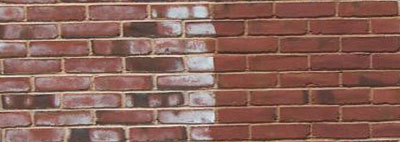
In this example, you can see a heavy build up of efflorescence. EF-Fortless, undiluted, was applied to the right side of this wall and left on the surface. The efflorescence was completely removed.
Calcite is another problem with masonry, especially brick and block, which can be extremely difficult to remove. Calcite appears as a thick whitish deposit which usually builds up over time. It is typically formed when excess moisture evaporates leaving behind a heavy calcium residue. Calcite can be chemically removed with a combination of Calcite Presoak (undiluted) followed by NMD 80 (diluted 4:1), and finished with a pressure washer rinse.
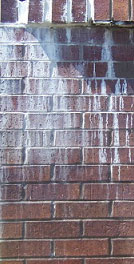
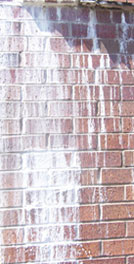
In this example, Calcite Presoak was applied to the heavy calcite deposits three times without rinsing in between. Pinholes in the calcite indicated that penetration had occurred and it was time to follow with NMD 80. After one application of NMD 80 and a pressure rinse, the calcite deposits were removed, while the brick and mortar were undamaged.
Manganese and Vanadium are naturally occurring minerals in certain seams of clay. Like soluble salts, they are released when an abundance of water migrates through a masonry structure. In some instances they are also added as an additional colorant, especially in lighter colored brick.
The most effective way to prevent manganese or vanadium from forming is to keep the brick covered before installation. Do not allow rain to enter the wall during construction. If these steps are not possible, the next thing to do is allow the wall to dry completely prior to post construction cleaning. This allows any staining to migrate to the surface for removal (along with smears) using NMD 80 (4:1).
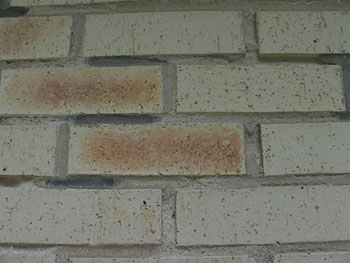
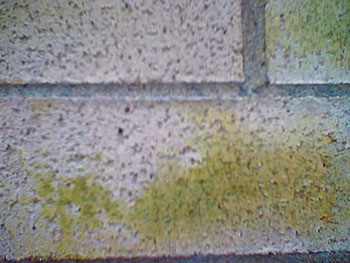
Manganese generally appears as a brownish stain on the surface. Vanadium generally appear as a greenish stain on the surface (as seen in these examples). Both stains are easily removed with OneRestore®.
Even if proper precautions were not taken during the construction phase, or if the wall was not allowed to dry thoroughly and then cleaned with NMD 80, there are still other options for removing the unsightly stains.
Removing the stains with OneRestore® (while more costly than prevention) is equally effective. In most cases, a single application of OneRestore® applied to the surface undiluted is all you will need. Allow it to dwell for approximately ten minutes and then pressure rinse off. In some instances, additional applications may be needed.
**For more information on our position regarding Manganese and Vanadium stains, please review our Vanadium and Manganese Issue Statement.